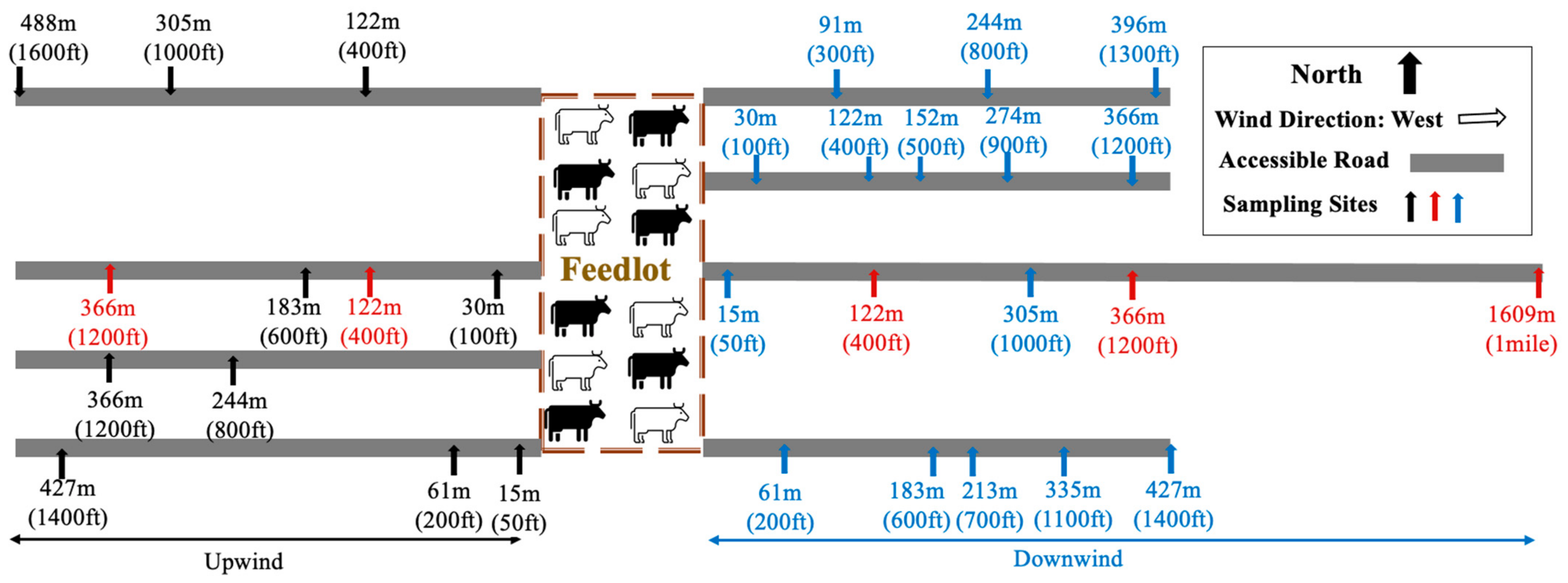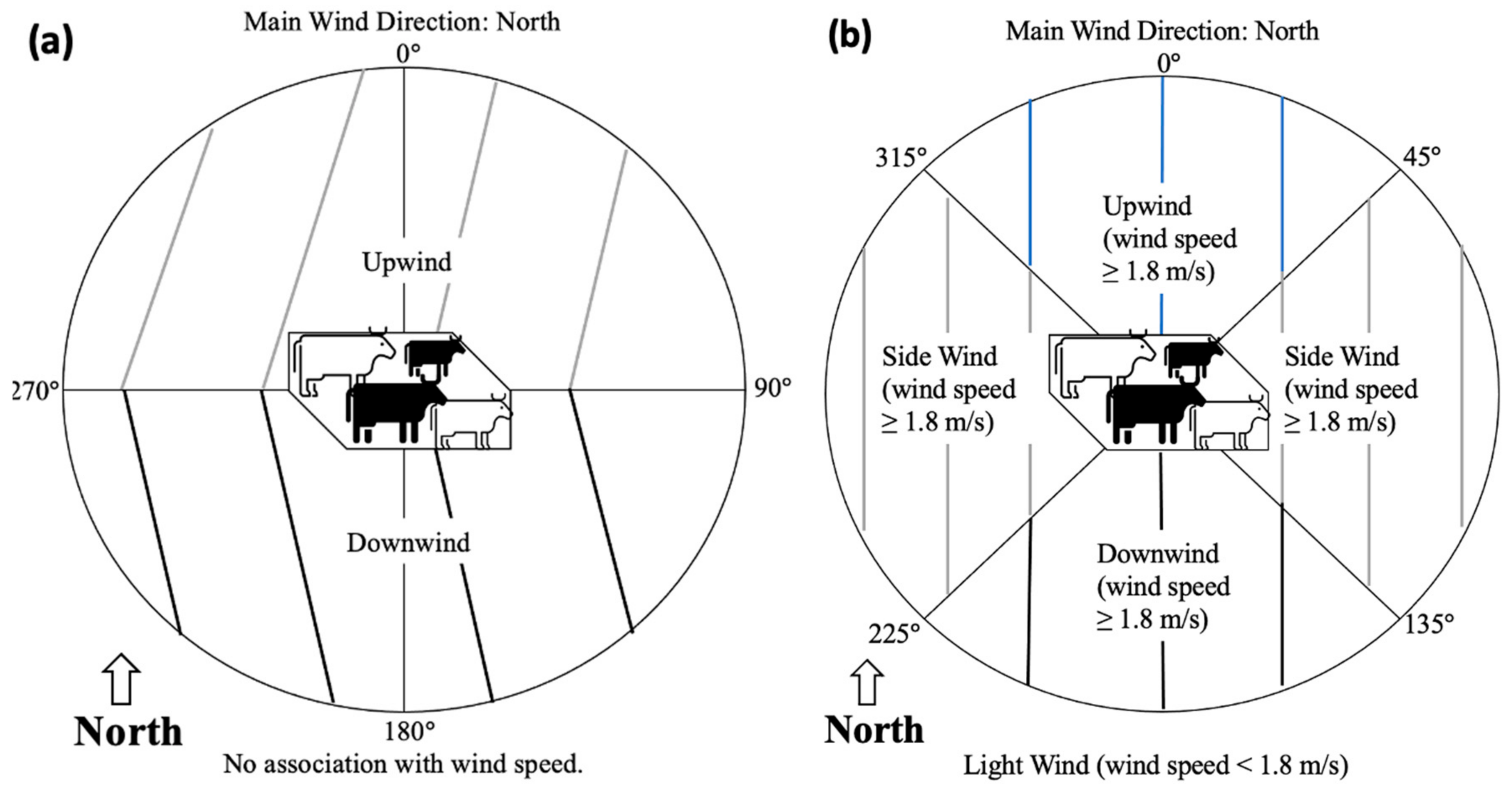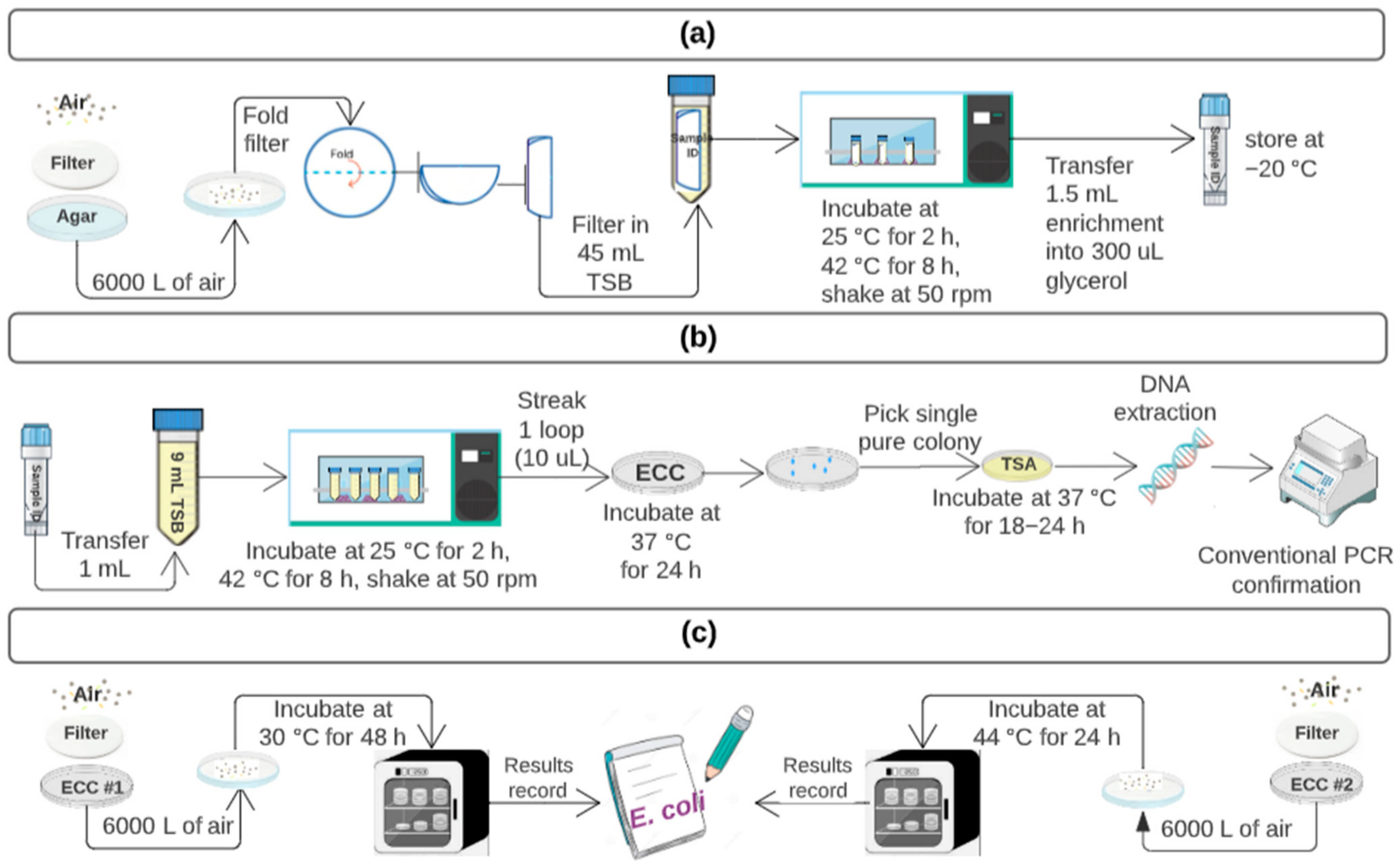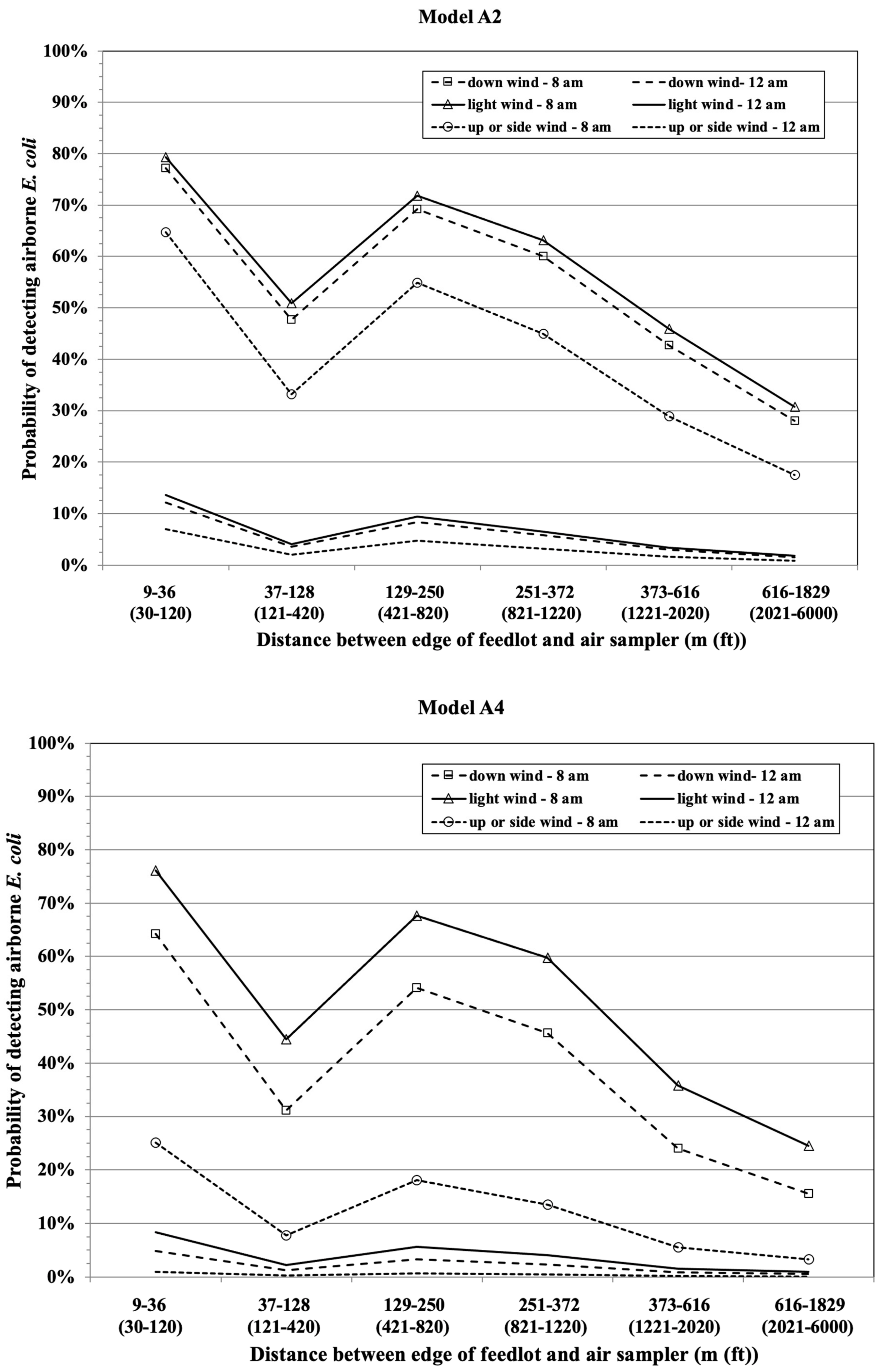Low to Zero Concentrations of Airborne Bacterial Pathogens and Indicator E. coli in Proximity to Beef Cattle Feedlots in Imperial Valley, California
Abstract
1. Introduction
2. Materials and Methods
2.1. Site Selection
2.2. Sample Collection
2.3. Microbiological Analysis
2.4. Statistical Analyses
3. Results
3.1. Meteorological Conditions during Sampling
3.2. Detection of Bacterial Pathogens and Indicator E. coli
| Site | Distance from Feedlot Edge Meter (Feet) | Total Air Samples | E. coli | qPCR Screen on Enrichments | qPCR Confirmed Isolates | ||||||
|---|---|---|---|---|---|---|---|---|---|---|---|
| Mean (Min–Max) | % Positive | % Positive | % Suspect Positive | % Confirmed Positive | |||||||
| Direct Count (CFU/6000 L) | Enrichments (+ or −/6000 L) | E. coli O157 | stx 1/2 | Salm | E. coli O157 | STEC stx 1/2 | Salm | ||||
| All sites (random distance and LGMA-fixed distance) | 9–36 (30–120) | 22 | 0.95 (0–19) | 13.64% | 31.82% | 0 | 4.55% | 0 | 0 | 0 | 0 |
| 37–128 (121–420) | 79 | 0.13 (0–5) | 5.06% | 12.66% | 0 | 3.80% | 0 | 0 | 0 | 0 | |
| 129–250 (421–820) | 47 | 0.21 (0–8) | 6.38% | 19.15% | 0 | 12.77% | 0 | 0 | 0 | 0 | |
| 251–372 (821–1220) | 94 | 0.09 (0–3) | 6.38% | 20.21% | 0 | 2.13% | 0 | 0 | 0 | 0 | |
| 373–616 (1221–2020) | 26 | 0.04 0–1) | 3.85% | 7.69% | 0 | 7.69% | 3.85% | 0 | 0 | 0 | |
| 616–1829 (2021–6000) | 32 | 0.03 (0–1) | 3.13% | 9.38% | 0 | 6.25% | 0 | 0 | 0 | 0 | |
| Total | 300 | 0.17 (0–19) | 6.00% | 16.67% | 0 | 5.33% | 0.33% | 0 | 0 | 0 | |
| Fixed sites at LGMA guidance distances | ~122 (~400) | 60 | 0.08 (0–3) | 5.00% | 8.33% | 0 | 5.00% | 0 | 0 | 0 | 0 |
| ~366 (~1200) | 60 | 0.05 (0–3) | 1.67% | 15.00% | 0 | 3.33% | 0 | 0 | 0 | 0 | |
| ~1609 (~1 mile) | 30 | 0.03 (0–1) | 3.33% | 10.00% | 0 | 6.67% | 0 | 0 | 0 | 0 | |
| Total | 150 | 0.06 (0–3) | 3.33% | 11.33% | 0 | 4.67% | 0 | 0 | 0 | 0 | |
| Random distance | 9–36 (30–120) | 22 | 0.95 (0–19) | 13.64% | 31.82% | 0 | 4.55% | 0 | 0 | 0 | 0 |
| 37–128 (121–420) | 29 | 0.21 (0–5) | 6.90% | 24.14% | 0 | 3.45% | 0 | 0 | 0 | 0 | |
| 129–250 (421–820) | 37 | 0.24 (0–8) | 5.41% | 18.92% | 0 | 13.51% | 0 | 0 | 0 | 0 | |
| (251–372) 821–1220 | 37 | 0.14 (0–1) | 13.51% | 29.73% | 0 | 0 | 0 | 0 | 0 | 0 | |
| 373–616 (1221–2020) | 25 | 0.04 (0–1) | 4.00% | 4.00% | 0 | 8.00% | 4.00% | 0 | 0 | 0 | |
| Total | 150 | 0.28 (0–19) | 8.67% | 22.00% | 0 | 6.00% | 0.67% | 0 | 0 | 0 | |
3.3. Logistic Regression Models for the Association between Detecting Airborne E. coli and Various Environmental and Seasonal Variables in Proximity to Feedlots
4. Discussion
5. Conclusions
Author Contributions
Funding
Data Availability Statement
Acknowledgments
Conflicts of Interest
References
- Center for Disease Control and Prevention. Reports of Selected E. coli Outbreak Investigations. Available online: https://www.cdc.gov/ecoli/outbreaks.html (accessed on 10 January 2023).
- California Leafy Green Products Handler Marketing Agreement. Commodity Specific Food Safety Guidelines for the Production and Harvest of Lettuce and Leafy Greens. Available online: https://lgma-assets.sfo2.digitaloceanspaces.com/downloads/CA_LGMA_METRICS_FINAL_VERSION_Accessible_Jan2020.pdf (accessed on 10 January 2023).
- Berry, E.D.; Wells, J.E.; Bono, J.L.; Woodbury, B.L.; Kalchayanand, N.; Norman, K.N.; Suslow, T.V.; López-Velasco, G.; Millner, P.D. Effect of Proximity to a Cattle Feedlot on Escherichia coli O157:H7 Contamination of Leafy Greens and Evaluation of the Potential for Airborne Transmission. Appl. Environ. Microbiol. 2015, 81, 1101–1110. [Google Scholar] [CrossRef] [PubMed]
- Wilson, S.C.; Morrow-Tesch, J.; Straus, D.C.; Cooley, J.D.; Wong, W.C.; Mitlöhner, F.M.; McGlone, J.J. Airborne Microbial Flora in a Cattle Feedlot. Appl. Environ. Microbiol. 2002, 68, 3238–3242. [Google Scholar] [CrossRef] [PubMed]
- Riccardi, C.; Di Filippo, P.; Pomata, D.; Simonetti, G.; Castellani, F.; Uccelletti, D.; Bruni, E.; Federici, E.; Buiarelli, F. Comparison of Analytical Approaches for Identifying Airborne Microorganisms in a Livestock Facility. Sci. Total Environ. 2021, 783, 147044. [Google Scholar] [CrossRef] [PubMed]
- Glaize, A.; Young, M.; Harden, L.; Gutierrez-Rodriguez, E.; Thakur, S. The Effect of Vegetation Barriers at Reducing the Transmission of Salmonella and Escherichia coli from Animal Operations to Fresh Produce. Int. J. Food Microbiol. 2021, 347, 109196. [Google Scholar] [CrossRef]
- Jiang, W.; Liang, P.; Wang, B.; Fang, J.; Lang, J.; Tian, G.; Jiang, J.; Zhu, T.F. Optimized DNA Extraction and Metagenomic Sequencing of Airborne Microbial Communities. Nat. Protoc. 2015, 10, 768–779. [Google Scholar] [CrossRef]
- Anastasi, E.M.; Matthews, B.; Gundogdu, A.; Vollmerhausen, T.L.; Ramos, N.L.; Stratton, H.; Ahmed, W.; Katouli, M. Prevalence and Persistence of Escherichia coli Strains with Uropathogenic Virulence Characteristics in Sewage Treatment Plants. Appl. Environ. Microbiol. 2010, 76, 5882–5886. [Google Scholar] [CrossRef]
- Chen, J.; Griffiths, M.W. PCR Differentiation of Escherichia coli from Other Gram-Negative Bacteria Using Primers Derived from the Nucleotide Sequences Flanking the Gene Encoding the Universal Stress Protein. Lett. Appl. Microbiol. 1998, 27, 369–371. [Google Scholar] [CrossRef]
- Atwill, E.R.; Chase, J.A.; Oryang, D.; Bond, R.F.; Koike, S.T.; Cahn, M.D.; Anderson, M.; Mokhtari, A.; Dennis, S. Transfer of Escherichia coli O157:H7 from Simulated Wildlife Scat onto Romaine Lettuce during Foliar Irrigation. J. Food Prot. 2015, 78, 240–247. [Google Scholar] [CrossRef]
- Suo, B.; He, Y.; Tu, S. A Multiplex Real-Time Polymerase Chain Reaction for Simultaneous Detection of Salmonella spp., Escherichia coli O157, and Listeria Monocytogenes in Meat Products. Foodborne Pathog. Dis. 2010, 7, 619–628. [Google Scholar] [CrossRef]
- Baker, C.A.; De, J.; Bertoldi, B.; Dunn, L.; Chapin, T.; Jay-Russell, M.; Danyluk, M.D.; Schneider, K.R. Prevalence and Concentration of Stx+ E. coli and E. coli O157 in Bovine Manure from Florida Farms. PLoS ONE 2019, 14, e0217445. [Google Scholar] [CrossRef]
- Gorski, L.; Parker, C.T.; Liang, A.; Cooley, M.B.; Jay-Russell, M.T.; Gordus, A.G.; Atwill, E.R.; Mandrell, R.E. Prevalence, Distribution, and Diversity of Salmonella enterica in a Major Produce Region of California. Appl. Environ. Microbiol. 2011, 77, 2734–2748. [Google Scholar] [CrossRef] [PubMed]
- Paddock, Z.; Shi, X.; Bai, J.; Nagaraja, T.G. Applicability of a Multiplex PCR to Detect O26, O45, O103, O111, O121, O145, and O157 Serogroups of Escherichia coli in Cattle Feces. Vet. Microbiol. 2012, 156, 381–388. [Google Scholar] [CrossRef] [PubMed]
- Li, X.; Chase, J.A.; Bond, R.F.; Lor, P.; Fernandez, K.; Nguyen, T.H.; Partyka, M.L.; Thiptara, A.; Atwill, E.R. Microbiological Safety of Popular Recreation Swimming Sites in Central California. Environ. Monit. Assess. 2019, 191, 456. [Google Scholar] [CrossRef] [PubMed]
- Partyka, M.L.; Bond, R.F.; Chase, J.A.; Atwill, E.R. Spatial and Temporal Variability of Bacterial Indicators and Pathogens in Six California Reservoirs during Extreme Drought. Water Res. 2018, 129, 436–446. [Google Scholar] [CrossRef] [PubMed]
- Behzad, H.; Gojobori, T.; Mineta, K. Challenges and Opportunities of Airborne Metagenomics. Genome Biol. Evol. 2015, 7, 1216–1226. [Google Scholar] [CrossRef] [PubMed]
- Burrows, S.M.; Elbert, W.; Lawrence, M.G.; Pöschl, U. Bacteria in the Global Atmosphere—Part 1: Review and Synthesis of Literature Data for Different Ecosystems. Atmos. Chem. Phys. 2009, 9, 9263–9280. [Google Scholar] [CrossRef]
- Li, X.; Chen, H.; Yao, M. Microbial Emission Levels and Diversities from Different Land Use Types. Environ. Int. 2020, 143, 105988. [Google Scholar] [CrossRef] [PubMed]
- Paton, A.W.; Paton, J.C. Enterobacter Cloacae Producing a Shiga-Like Toxin II-Related Cytotoxin Associated with a Case of Hemolytic-Uremic Syndrome. J. Clin. Microbiol. 1996, 34, 463–465. [Google Scholar] [CrossRef]
- Mallick, E.M.; McBee, M.E.; Vanguri, V.K.; Melton-Celsa, A.R.; Schlieper, K.; Karalius, B.J.; O’Brien, A.D.; Butterton, J.R.; Leong, J.M.; Schauer, D.B. A Novel Murine Infection Model for Shiga Toxin-Producing Escherichia coli. J. Clin. Investig. 2012, 122, 4012–4024. [Google Scholar] [CrossRef]
- Hoar, B.R.; Atwill, E.R.; Carlton, L.; Celis, J.; Carabez, J.; Nguyen, T. Buffers between Grazing Sheep and Leafy Crops Augment Food Safety. Calif. Agric. 2013, 67, 104–109. [Google Scholar] [CrossRef]
- Dungan, R.S.; Leytem, A.B.; Verwey, S.A.; Bjorneberg, D.L. Assessment of Bioaerosols at a Concentrated Dairy Operation. Aerobiologia 2010, 26, 171–184. [Google Scholar] [CrossRef]
- De Niro, J.L. Airborne Transport of Foodborne Pathogens from Bovine Manure to Vegetable Surfaces. Master’s Thesis, The Ohio State University, Columbus, OH, USA, 2013. [Google Scholar]
- Grundnig, P.W.; Höflinger, W.; Mauschitz, G.; Liu, Z.; Zhang, G.; Wang, Z. Influence of Air Humidity on the Suppression of Fugitive Dust by Using a Water-Spraying System. China Particuol. 2006, 4, 229–233. [Google Scholar] [CrossRef]
- Zhen, Q.; Deng, Y.; Wang, Y.; Wang, X.; Zhang, H.; Sun, X.; Ouyang, Z. Meteorological Factors Had More Impact on Airborne Bacterial Communities than Air Pollutants. Sci. Total Environ. 2017, 601–602, 703–712. [Google Scholar] [CrossRef] [PubMed]
- Zhong, S.; Zhang, L.; Jiang, X.; Gao, P. Comparison of Chemical Composition and Airborne Bacterial Community Structure in PM2.5 during Haze and Non-Haze Days in the Winter in Guilin, China. Sci. Total Environ. 2019, 655, 202–210. [Google Scholar] [CrossRef] [PubMed]
- Després, V.R.; Huffman, J.A.; Burrows, S.M.; Hoose, C.; Safatov, A.S.; Buryak, G.; Fröhlich-Nowoisky, J.; Elbert, W.; Andreae, M.O.; Pöschl, U.; et al. Primary Biological Aerosol Particles in the Atmosphere: A Review. Tellus B Chem. Phys. Meteorol. 2012, 64, 15598. [Google Scholar] [CrossRef]
- Dungan, R.S.; Leytem, A.B.; Bjorneberg, D.L. Concentrations of Airborne Endotoxin and Microorganisms at a 10,000-Cow Open-Freestall Dairy. J. Anim. Sci. 2011, 89, 3300–3309. [Google Scholar] [CrossRef]
- Sanz, S.; Olarte, C.; Martínez-Olarte, R.; Navajas-Benito, E.V.; Alonso, C.A.; Hidalgo-Sanz, S.; Somalo, S.; Torres, C. Airborne Dissemination of Escherichia coli in a Dairy Cattle Farm and Its Environment. Int. J. Food Microbiol. 2015, 197, 40–44. [Google Scholar] [CrossRef]
- Lighthart, B.; Mohr, A.J. Estimating Downwind Concentrations of Viable Airborne Microorganisms in Dynamic Atmospheric Conditions. Appl. Environ. Microbiol. 1987, 53, 1580–1583. [Google Scholar] [CrossRef]
- Gandolfi, I.; Bertolini, V.; Bestetti, G.; Ambrosini, R.; Innocente, E.; Rampazzo, G.; Papacchini, M.; Franzetti, A. Spatio-Temporal Variability of Airborne Bacterial Communities and Their Correlation with Particulate Matter Chemical Composition across Two Urban Areas. Appl. Microbiol. Biotechnol. 2015, 99, 4867–4877. [Google Scholar] [CrossRef]
- Bowers, R.M.; Clements, N.; Emerson, J.B.; Wiedinmyer, C.; Hannigan, M.P.; Fierer, N. Seasonal Variability in Bacterial and Fungal Diversity of the Near-Surface Atmosphere. Environ. Sci. Technol. 2013, 47, 12097–12106. [Google Scholar] [CrossRef]
- Sabariego, S.; Díaz De La Guardia, C.; Alba, F. The Effect of Meteorological Factors on the Daily Variation of Airborne Fungal Spores in Granada (Southern Spain). Int. J. Biometeorol. 2000, 44, 1–5. [Google Scholar] [CrossRef] [PubMed]
- U.S. Food & Drug Administration. Leafy Greens STEC Action Plan. Available online: https://www.fda.gov/food/foodborne-pathogens/leafy-greens-stec-action-plan (accessed on 22 October 2022).





| Model Variable | Level of Categorical Variable | In Situ Kestrel | Weather Station | ||||||
|---|---|---|---|---|---|---|---|---|---|
| Coef. | p-Value | OR | 95% CI | Coef. | p-Value | OR | 95% CI | ||
| Model A1 | Model A3 | ||||||||
| Hour sample was taken | −0.87 | <0.01 * | 0.42 | (0.30, 0.58) | −0.88 | <0.01 * | 0.41 | (0.29, 0.59) | |
| (1–24 h) | |||||||||
| Rel. humidity (0–100) | −0.04 | 0.02 * | 0.96 | (0.93, 0.99) | −0.03 | 0.02 * | 0.97 | (0.94, 0.995) | |
| Wind speed (m/s) | NS | −0.47 | 0.01 * | 0.63 | (0.44, 0.90) | ||||
| Dust-generating activity a | Present | 0.94 | 0.049 * | 2.57 | (1.01, 6.56) | NS | |||
| Absent b | 0 | - | 1 | - | |||||
| Distance between feedlot edge and air sampler m (ft) | 9–36 (30–120) | 2.22 | 0.01 * | 9.21 | (1.65, 51.38) | 2.58 | <0.01 * | 13.23 | (2.25, 77.87) |
| 37–128 (121–420) | 0.94 | 0.25 | 2.55 | (0.52, 12.46) | 1.19 | 0.15 | 3.3 | (0.66, 16.48) | |
| 129–250 (421–820) | 1.77 | 0.04 * | 5.88 | (1.11, 31.04) | 2.09 | 0.02 * | 8.08 | (1.45, 45.10) | |
| 251–372 (821–1220) | 1.46 | 0.06 | 4.29 | (0.97, 18.99) | 1.63 | 0.04 * | 5.12 | (1.12, 23.41) | |
| 373–616 (1221–2020) | 0.59 | 0.58 | 1.81 | (0.22, 14.80) | 0.63 | 0.56 | 1.88 | (0.22, 16.00) | |
| 616–1829 (2021–6000) b | 0 | - | 1 | - | 0 | - | 1 | - | |
| Month when sampling occurred | November 2020 | 1.38 | 0.1 | 3.96 | (0.78, 20.14) | 0.17 | 0.84 | 1.18 | (0.23, 6.22) |
| December 2020 | 0.83 | 0.27 | 2.3 | (0.52, 10.13) | 0.31 | 0.7 | 1.36 | (0.29, 6.52) | |
| January 2021 | 2.09 | <0.01 * | 8.06 | (2.02, 32.14) | 1.43 | 0.05 * | 4.17 | (1.03, 16.83) | |
| February 2021 | 1.71 | 0.01 * | 5.53 | (1.46, 20.92) | 1.12 | 0.1 | 3.07 | (0.80, 11.81) | |
| March 2021 | 2.22 | <0.01 * | 9.23 | (2.43, 35.07) | 1.69 | 0.01 * | 5.44 | (1.45, 20.47) | |
| April 2021 b | 0 | - | 1 | - | 0 | - | 1 | - | |
| Position of air sampler relative to feedlot and wind direction (180° partitions) | Downwind | 0.79 | 0.045 * | 2.2 | (1.02, 4.76) | 1.03 | 0.01 * | 2.79 | (1.34, 5.82) |
| Upwind b | 0 | - | 1 | - | 0 | - | 1 | - | |
| Model A2 | Model A4 | ||||||||
| Hour sample was taken | −0.8 | <0.01 * | 0.45 | (0.33, 0.62) | −0.89 | <0.01 * | 0.41 | (0.29, 0.59) | |
| (1–24 h) | |||||||||
| Rel. humidity (0–100) | −0.04 | 0.03 * | 0.96 | (0.93, 0.997) | −0.04 | 0.01 * | 0.96 | (0.93, 0.99) | |
| Distance between feedlot edge and air sampler m (ft) | 9–36 (30–120) | 2.16 | 0.01 * | 8.7 | (1.58, 48.02) | 2.28 | 0.01 * | 9.74 | (1.70, 55.83) |
| 37–128 (121–420) | 0.85 | 0.28 | 2.35 | (0.49, 11.21) | 0.9 | 0.27 | 2.46 | (0.50, 12.02) | |
| 129–250 (421–820) | 1.75 | 0.04 * | 5.76 | (1.11, 29.83) | 1.86 | 0.03 * | 6.43 | (1.20, 34.42) | |
| 251–372 (821–1220) | 1.35 | 0.07 | 3.87 | (0.89, 16.75) | 1.52 | 0.05 | 4.59 | (1.03, 20.52) | |
| 373–616 (1221–2020) | 0.65 | 0.54 | 1.91 | (0.24, 15.29) | 0.54 | 0.61 | 1.71 | (0.21, 13.85) | |
| 616–1829 (2021–6000) b | 0 | - | 1 | - | 0 | - | 1 | - | |
| Month when sampling occurred | November 2020 | 0.95 | 0.26 | 2.59 | (0.50, 13.48) | 0.11 | 0.9 | 1.12 | (0.21, 6.04) |
| December2020 | 0.6 | 0.44 | 1.83 | (0.39, 8.57) | 0.5 | 0.54 | 1.66 | (0.33, 8.29) | |
| January 2021 | 1.86 | 0.01 * | 6.4 | (1.55, 26.41) | 1.72 | 0.02 * | 5.59 | (1.32, 23.69) | |
| February 2021 | 1.49 | 0.03 * | 4.46 | (1.18, 16.83) | 1.44 | 0.04 * | 4.21 | (1.04, 17.00) | |
| March 2021 | 2.07 | <0.01 * | 7.92 | (2.10, 29.90) | 2.1 | <0.01 * | 8.14 | (2.10, 31.62) | |
| April 2021 b | 0 | - | 1 | - | 0 | - | 1 | - | |
| Position of air sampler relative to feedlot and wind direction (90° partitions) | Downwind | 0.61 | 0.17 | 1.84 | (0.77, 4.44) | 1.68 | 0.01 * | 5.38 | (1.45, 19.94) |
| Light wind c | 0.74 | 0.13 | 2.10 | (0.80, 5.52) | 2.25 | <0.01 * | 9.46 | (2.83, 31.68) | |
| Up or side wind b,c | 0 | - | 1 | - | 0 | - | 1 | - | |
| Dust-generating activity a | Present | 0.98 | 0.04 * | 2.67 | (1.03, 6.92) | NS | |||
| Absent b | 0 | - | 1 | - | |||||
Disclaimer/Publisher’s Note: The statements, opinions and data contained in all publications are solely those of the individual author(s) and contributor(s) and not of MDPI and/or the editor(s). MDPI and/or the editor(s) disclaim responsibility for any injury to people or property resulting from any ideas, methods, instructions or products referred to in the content. |
© 2023 by the authors. Licensee MDPI, Basel, Switzerland. This article is an open access article distributed under the terms and conditions of the Creative Commons Attribution (CC BY) license (https://creativecommons.org/licenses/by/4.0/).
Share and Cite
Wei, X.; Aggrawal, A.; Bond, R.F.; Atwill, E.R. Low to Zero Concentrations of Airborne Bacterial Pathogens and Indicator E. coli in Proximity to Beef Cattle Feedlots in Imperial Valley, California. Microorganisms 2023, 11, 411. https://doi.org/10.3390/microorganisms11020411
Wei X, Aggrawal A, Bond RF, Atwill ER. Low to Zero Concentrations of Airborne Bacterial Pathogens and Indicator E. coli in Proximity to Beef Cattle Feedlots in Imperial Valley, California. Microorganisms. 2023; 11(2):411. https://doi.org/10.3390/microorganisms11020411
Chicago/Turabian StyleWei, Xiaohong, Amlan Aggrawal, Ronald F. Bond, and Edward R. Atwill. 2023. "Low to Zero Concentrations of Airborne Bacterial Pathogens and Indicator E. coli in Proximity to Beef Cattle Feedlots in Imperial Valley, California" Microorganisms 11, no. 2: 411. https://doi.org/10.3390/microorganisms11020411
APA StyleWei, X., Aggrawal, A., Bond, R. F., & Atwill, E. R. (2023). Low to Zero Concentrations of Airborne Bacterial Pathogens and Indicator E. coli in Proximity to Beef Cattle Feedlots in Imperial Valley, California. Microorganisms, 11(2), 411. https://doi.org/10.3390/microorganisms11020411





